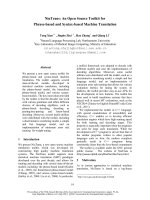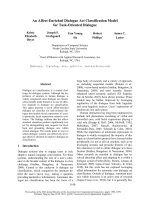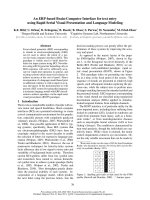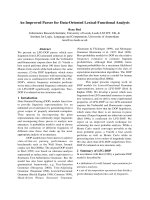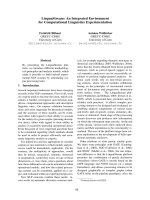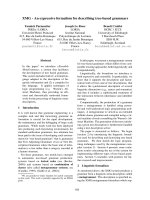Báo cáo khoa học: "An Optimization Tool for MaltParser" pptx
Bạn đang xem bản rút gọn của tài liệu. Xem và tải ngay bản đầy đủ của tài liệu tại đây (157.03 KB, 5 trang )
Proceedings of the 13th Conference of the European Chapter of the Association for Computational Linguistics, pages 58–62,
Avignon, France, April 23 - 27 2012.
c
2012 Association for Computational Linguistics
MaltOptimizer: An Optimization Tool for MaltParser
Miguel Ballesteros
Complutense University of Madrid
Spain
Joakim Nivre
Uppsala University
Sweden
Abstract
Data-driven systems for natural language
processing have the advantage that they can
easily be ported to any language or domain
for which appropriate training data can be
found. However, many data-driven systems
require careful tuning in order to achieve
optimal performance, which may require
specialized knowledge of the system. We
present MaltOptimizer, a tool developed to
facilitate optimization of parsers developed
using MaltParser, a data-driven dependency
parser generator. MaltOptimizer performs
an analysis of the training data and guides
the user through a three-phase optimization
process, but it can also be used to perform
completely automatic optimization. Exper-
iments show that MaltOptimizer can im-
prove parsing accuracy by up to 9 percent
absolute (labeled attachment score) com-
pared to default settings. During the demo
session, we will run MaltOptimizer on dif-
ferent data sets (user-supplied if possible)
and show how the user can interact with the
system and track the improvement in pars-
ing accuracy.
1 Introduction
In building NLP applications for new languages
and domains, we often want to reuse components
for tasks like part-of-speech tagging, syntactic
parsing, word sense disambiguation and semantic
role labeling. From this perspective, components
that rely on machine learning have an advantage,
since they can be quickly adapted to new settings
provided that we can find suitable training data.
However, such components may require careful
feature selection and parameter tuning in order to
give optimal performance, a task that can be dif-
ficult for application developers without special-
ized knowledge of each component.
A typical example is MaltParser (Nivre et al.,
2006), a widely used transition-based dependency
parser with state-of-the-art performance for many
languages, as demonstrated in the CoNLL shared
tasks on multilingual dependency parsing (Buch-
holz and Marsi, 2006; Nivre et al., 2007). Malt-
Parser is an open-source system that offers a wide
range of parameters for optimization. It imple-
ments nine different transition-based parsing al-
gorithms, each with its own specific parameters,
and it has an expressive specification language
that allows the user to define arbitrarily complex
feature models. Finally, any combination of pars-
ing algorithm and feature model can be combined
with a number of different machine learning al-
gorithms available in LIBSVM (Chang and Lin,
2001) and LIBLINEAR (Fan et al., 2008). Just
running the system with default settings when
training a new parser is therefore very likely to
result in suboptimal performance. However, se-
lecting the best combination of parameters is a
complicated task that requires knowledge of the
system as well as knowledge of the characteris-
tics of the training data.
This is why we present MaltOptimizer, a tool
for optimizing MaltParser for a new language
or domain, based on an analysis of the train-
ing data. The optimization is performed in three
phases: data analysis, parsing algorithm selec-
tion, and feature selection. The tool can be run
in “batch mode” to perform completely automatic
optimization, but it is also possible for the user to
manually tune parameters after each of the three
phases. In this way, we hope to cater for users
58
without specific knowledge of MaltParser, who
can use the tool for black box optimization, as
well as expert users, who can use it interactively
to speed up optimization. Experiments on a num-
ber of data sets show that using MaltOptimizer for
completely automatic optimization gives consis-
tent and often substantial improvements over the
default settings for MaltParser.
The importance of feature selection and param-
eter optimization has been demonstrated for many
NLP tasks (Kool et al., 2000; Daelemans et al.,
2003), and there are general optimization tools for
machine learning, such as Paramsearch (Van den
Bosch, 2004). In addition, Nilsson and Nugues
(2010) has explored automatic feature selection
specifically for MaltParser, but MaltOptimizer is
the first system that implements a complete cus-
tomized optimization process for this system.
In the rest of the paper, we describe the opti-
mization process implemented in MaltOptimizer
(Section 2), report experiments (Section 3), out-
line the demonstration (Section 4), and conclude
(Section 5). A more detailed description of Malt-
Optimizer with additional experimental results
can be found in Ballesteros and Nivre (2012).
2 The MaltOptimizer System
MaltOptimizer is written in Java and implements
an optimization procedure for MaltParser based
on the heuristics described in Nivre and Hall
(2010). The system takes as input a training
set, consisting of sentences annotated with depen-
dency trees in CoNLL data format,
1
and outputs
an optimized MaltParser configuration together
with an estimate of the final parsing accuracy.
The evaluation metric that is used for optimiza-
tion by default is the labeled attachment score
(LAS) excluding punctuation, that is, the percent-
age of non-punctuation tokens that are assigned
the correct head and the correct label (Buchholz
and Marsi, 2006), but other options are available.
For efficiency reasons, MaltOptimizer only ex-
plores linear multiclass SVMs in LIBLINEAR.
2.1 Phase 1: Data Analysis
After validating that the data is in valid CoNLL
format, using the official validation script from
the CoNLL-X shared task,
2
the system checks the
1
/>2
/>minimum Java heap space needed given the size
of the data set. If there is not enough memory
available on the current machine, the system in-
forms the user and automatically reduces the size
of the data set to a feasible subset. After these ini-
tial checks, MaltOptimizer checks the following
characteristics of the data set:
1. Number of words/sentences.
2. Existence of “covered roots” (arcs spanning
tokens with HEAD = 0).
3. Frequency of labels used for tokens with
HEAD = 0.
4. Percentage of non-projective arcs/trees.
5. Existence of non-empty feature values in the
LEMMA and FEATS columns.
6. Identity (or not) of feature values in the
CPOSTAG and POSTAG columns.
Items 1–3 are used to set basic parameters in the
rest of phase 1 (see below); 4 is used in the choice
of parsing algorithm (phase 2); 5 and 6 are rele-
vant for feature selection experiments (phase 3).
If there are covered roots, the system checks
whether accuracy is improved by reattaching
such roots in order to eliminate spurious non-
projectivity. If there are multiple labels for to-
kens with HEAD=0, the system tests which label
is best to use as default for fragmented parses.
Given the size of the data set, the system sug-
gests different validation strategies during phase
1. If the data set is small, it recommends us-
ing 5-fold cross-validation during subsequent op-
timization phases. If the data set is larger, it rec-
ommends using a single development set instead.
But the user can override either recommendation
and select either validation method manually.
When these checks are completed, MaltOpti-
mizer creates a baseline option file to be used as
the starting point for further optimization. The
user is given the opportunity to edit this option
file and may also choose to stop the process and
continue with manual optimization.
2.2 Phase 2: Parsing Algorithm Selection
MaltParser implements three groups of transition-
based parsing algorithms:
3
(i) Nivre’s algorithms
(Nivre, 2003; Nivre, 2008), (ii) Covington’s algo-
rithms (Covington, 2001; Nivre, 2008), and (iii)
3
Recent versions of MaltParser contains additional algo-
rithms that are currently not handled by MaltOptimizer.
59
Figure 1: Decision tree for best projective algorithm.
Figure 2: Decision tree for best non-projective algo-
rithm (+PP for pseudo-projective parsing).
Stack algorithms (Nivre, 2009; Nivre et al., 2009)
Both the Covington group and the Stack group
contain algorithms that can handle non-projective
dependency trees, and any projective algorithm
can be combined with pseudo-projective parsing
to recover non-projective dependencies in post-
processing (Nivre and Nilsson, 2005).
In phase 2, MaltOptimizer explores the parsing
algorithms implemented in MaltParser, based on
the data characteristics inferred in the first phase.
In particular, if there are no non-projective depen-
dencies in the training set, then only projective
algorithms are explored, including the arc-eager
and arc-standard versions of Nivre’s algorithm,
the projective version of Covington’s projective
parsing algorithm and the projective Stack algo-
rithm. The system follows a decision tree consid-
ering the characteristics of each algorithm, which
is shown in Figure 1.
On the other hand, if the training set con-
tains a substantial amount of non-projective de-
pendencies, MaltOptimizer instead tests the non-
projective versions of Covington’s algorithm and
the Stack algorithm (including a lazy and an eager
variant), and projective algorithms in combination
with pseudo-projective parsing. The system then
follows the decision tree shown in Figure 2.
If the number of trees containing non-
projective arcs is small but not zero, the sys-
tem tests both projective algorithms and non-
projective algorithms, following the decision trees
in Figure 1 and Figure 2 and picking the algorithm
that gives the best results after traversing both.
Once the system has finished testing each of the
algorithms with default settings, MaltOptimizer
tunes some specific parameters of the best per-
forming algorithm and creates a new option file
for the best configuration so far. The user is again
given the opportunity to edit the option file (or
stop the process) before optimization continues.
2.3 Phase 3: Feature Selection
In the third phase, MaltOptimizer tunes the fea-
ture model given all the parameters chosen so far
(especially the parsing algorithm). It starts with
backward selection experiments to ensure that all
features in the default model for the given pars-
ing algorithm are actually useful. In this phase,
features are omitted as long as their removal does
not decrease parsing accuracy. The system then
proceeds with forward selection experiments, try-
ing potentially useful features one by one. In this
phase, a threshold of 0.05% is used to determine
whether an improvement in parsing accuracy is
sufficient for the feature to be added to the model.
Since an exhaustive search for the best possible
feature model is impossible, the system relies on
a greedy optimization strategy using heuristics de-
rived from proven experience (Nivre and Hall,
2010). The major steps of the forward selection
experiments are the following:
4
1. Tune the window of POSTAG n-grams over
the parser state.
2. Tune the window of FORM features over the
parser state.
3. Tune DEPREL and POSTAG features over
the partially built dependency tree.
4. Add POSTAG and FORM features over the
input string.
5. Add CPOSTAG, FEATS, and LEMMA fea-
tures if available.
6. Add conjunctions of POSTAG and FORM
features.
These six steps are slightly different depending
on which algorithm has been selected as the best
in phase 2, because the algorithms have different
parsing orders and use different data structures,
4
For an explanation of the different feature columns such
as POSTAG, FORM, etc., see Buchholz and Marsi (2006) or
see />60
Language Default Phase 1 Phase 2 Phase 3 Diff
Arabic 63.02 63.03 63.84 65.56 2.54
Bulgarian 83.19 83.19 84.00 86.03 2.84
Chinese 84.14 84.14 84.95 84.95 0.81
Czech 69.94 70.14 72.44 78.04 8.10
Danish 81.01 81.01 81.34 83.86 2.85
Dutch 74.77 74.77 78.02 82.63 7.86
German 82.36 82.36 83.56 85.91 3.55
Japanese 89.70 89.70 90.92 90.92 1.22
Portuguese 84.11 84.31 84.75 86.52 2.41
Slovene 66.08 66.52 68.40 71.71 5.63
Spanish 76.45 76.45 76.64 79.38 2.93
Swedish 83.34 83.34 83.50 84.09 0.75
Turkish 57.79 57.79 58.29 66.92 9.13
Table 1: Labeled attachment score per phase and with
comparison to default settings for the 13 training sets
from the CoNLL-X shared task (Buchholz and Marsi,
2006).
but the steps are roughly equivalent at a certain
level of abstraction. After the feature selection
experiments are completed, MaltOptimizer tunes
the cost parameter of the linear SVM using a sim-
ple stepwise search. Finally, it creates a complete
configuration file that can be used to train Malt-
Parser on the entire data set. The user may now
continue to do further optimization manually.
3 Experiments
In order to assess the usefulness and validity of
the optimization procedure, we have run all three
phases of the optimization on all the 13 data sets
from the CoNLL-X shared task on multilingual
dependency parsing (Buchholz and Marsi, 2006).
Table 1 shows the labeled attachment scores with
default settings and after each of the three opti-
mization phases, as well as the difference between
the final configuration and the default.
5
The first thing to note is that the optimization
improves parsing accuracy for all languages with-
out exception, although the amount of improve-
ment varies considerably from about 1 percentage
point for Chinese, Japanese and Swedish to 8–9
points for Dutch, Czech and Turkish. For most
languages, the greatest improvement comes from
feature selection in phase 3, but we also see sig-
5
Note that these results are obtained using 80% of the
training set for training and 20% as a development test set,
which means that they are not comparable to the test results
from the original shared task, which were obtained using the
entire training set for training and a separate held-out test set
for evaluation.
nificant improvement from phase 2 for languages
with a substantial amount of non-projective de-
pendencies, such as Czech, Dutch and Slovene,
where the selection of parsing algorithm can be
very important. The time needed to run the op-
timization varies from about half an hour for the
smaller data sets to about one day for very large
data sets like the one for Czech.
4 System Demonstration
In the demonstration, we will run MaltOptimizer
on different data sets and show how the user can
interact with the system while keeping track of
improvements in parsing accuracy. We will also
explain how to interpret the output of the system,
including the final feature specification model, for
users that are not familiar with MaltParser. By re-
stricting the size of the input data set, we can com-
plete the whole optimization procedure in 10–15
minutes, so we expect to be able to complete a
number of cycles with different members of the
audience. We will also let the audience contribute
their own data sets for optimization, provided that
they are in CoNLL format.
6
5 Conclusion
MaltOptimizer is an optimization tool for Malt-
Parser, which is primarily aimed at application
developers who wish to adapt the system to a
new language or domain and who do not have
expert knowledge about transition-based depen-
dency parsing. Another potential user group con-
sists of researchers who want to perform compar-
ative parser evaluation, where MaltParser is often
used as a baseline system and where the use of
suboptimal parameter settings may undermine the
validity of the evaluation. Finally, we believe the
system can be useful also for expert users of Malt-
Parser as a way of speeding up optimization.
Acknowledgments
The first author is funded by the Spanish Ministry
of Education and Science (TIN2009-14659-C03-
01 Project), Universidad Complutense de Madrid
and Banco Santander Central Hispano (GR58/08
Research Group Grant). He is under the support
of the NIL Research Group ()
from the same university.
6
The system is available for download under an open-
source license at />61
References
Miguel Ballesteros and Joakim Nivre. 2012. MaltOp-
timizer: A System for MaltParser Optimization. In
Proceedings of the Eighth International Conference
on Language Resources and Evaluation (LREC).
Sabine Buchholz and Erwin Marsi. 2006. CoNLL-X
shared task on multilingual dependency parsing. In
Proceedings of the 10th Conference on Computa-
tional Natural Language Learning (CoNLL), pages
149–164.
Chih-Chung Chang and Chih-Jen Lin, 2001.
LIBSVM: A Library for Support Vec-
tor Machines. Software available at
/>Michael A. Covington. 2001. A fundamental algo-
rithm for dependency parsing. In Proceedings of
the 39th Annual ACM Southeast Conference, pages
95–102.
Walter Daelemans, V
´
eronique Hoste, Fien De Meul-
der, and Bart Naudts. 2003. Combined optimiza-
tion of feature selection and algorithm parameters
in machine learning of language. In Nada Lavrac,
Dragan Gamberger, Hendrik Blockeel, and Ljupco
Todorovski, editors, Machine Learning: ECML
2003, volume 2837 of Lecture Notes in Computer
Science. Springer.
R E. Fan, K W. Chang, C J. Hsieh, X R. Wang, and
C J. Lin. 2008. LIBLINEAR: A library for large
linear classification. Journal of Machine Learning
Research, 9:1871–1874.
Anne Kool, Jakub Zavrel, and Walter Daelemans.
2000. Simultaneous feature selection and param-
eter optimization for memory-based natural lan-
guage processing. In A. Feelders, editor, BENE-
LEARN 2000. Proceedings of the Tenth Belgian-
Dutch Conference on Machine Learning, pages 93–
100. Tilburg University, Tilburg.
Peter Nilsson and Pierre Nugues. 2010. Automatic
discovery of feature sets for dependency parsing. In
COLING, pages 824–832.
Joakim Nivre and Johan Hall. 2010. A quick guide
to MaltParser optimization. Technical report, malt-
parser.org.
Joakim Nivre and Jens Nilsson. 2005. Pseudo-
projective dependency parsing. In Proceedings of
the 43rd Annual Meeting of the Association for
Computational Linguistics (ACL), pages 99–106.
Joakim Nivre, Johan Hall, and Jens Nilsson. 2006.
Maltparser: A data-driven parser-generator for de-
pendency parsing. In Proceedings of the 5th In-
ternational Conference on Language Resources and
Evaluation (LREC), pages 2216–2219.
Joakim Nivre, Johan Hall, Sandra K
¨
ubler, Ryan Mc-
Donald, Jens Nilsson, Sebastian Riedel, and Deniz
Yuret. 2007. The CoNLL 2007 shared task on de-
pendency parsing. In Proceedings of the CoNLL
Shared Task of EMNLP-CoNLL 2007, pages 915–
932.
Joakim Nivre, Marco Kuhlmann, and Johan Hall.
2009. An improved oracle for dependency parsing
with online reordering. In Proceedings of the 11th
International Conference on Parsing Technologies
(IWPT’09), pages 73–76.
Joakim Nivre. 2003. An efficient algorithm for pro-
jective dependency parsing. In Proceedings of the
8th International Workshop on Parsing Technolo-
gies (IWPT), pages 149–160.
Joakim Nivre. 2008. Algorithms for deterministic in-
cremental dependency parsing. Computational Lin-
guistics, 34:513–553.
Joakim Nivre. 2009. Non-projective dependency
parsing in expected linear time. In Proceedings of
the Joint Conference of the 47th Annual Meeting of
the ACL and the 4th International Joint Conference
on Natural Language Processing of the AFNLP
(ACL-IJCNLP), pages 351–359.
Antal Van den Bosch. 2004. Wrapped progressive
sampling search for optimizing learning algorithm
parameters. In Proceedings of the 16th Belgian-
Dutch Conference on Artificial Intelligence.
62
